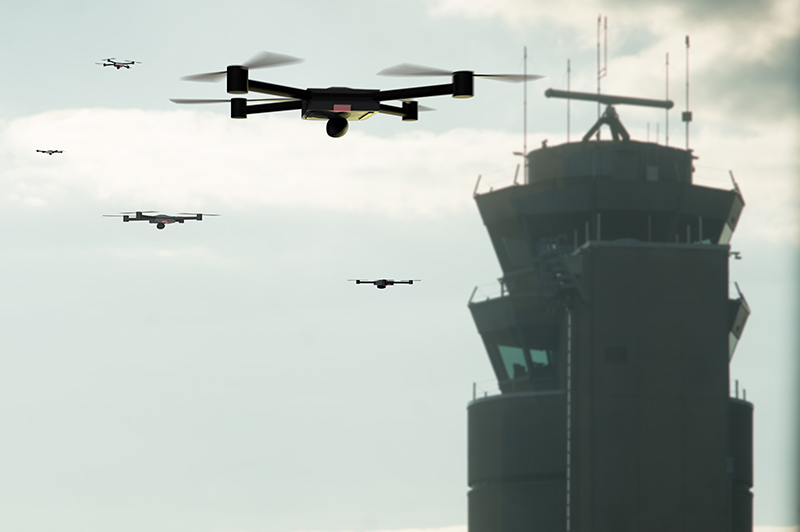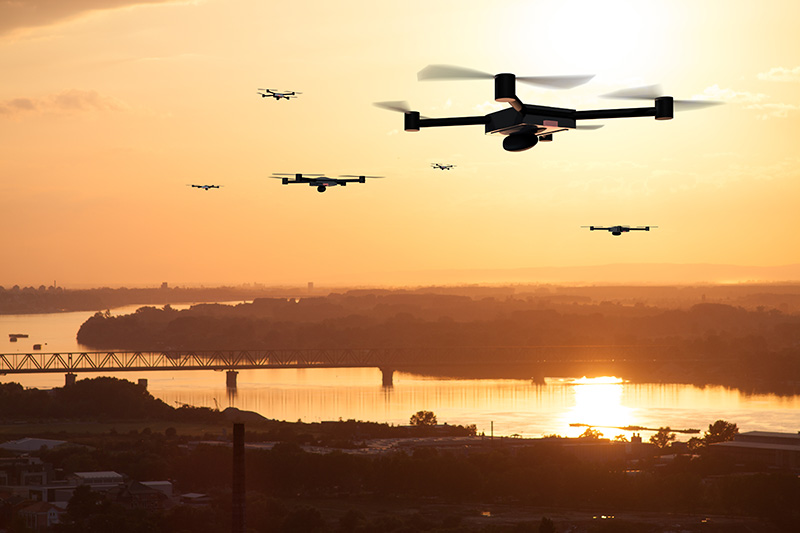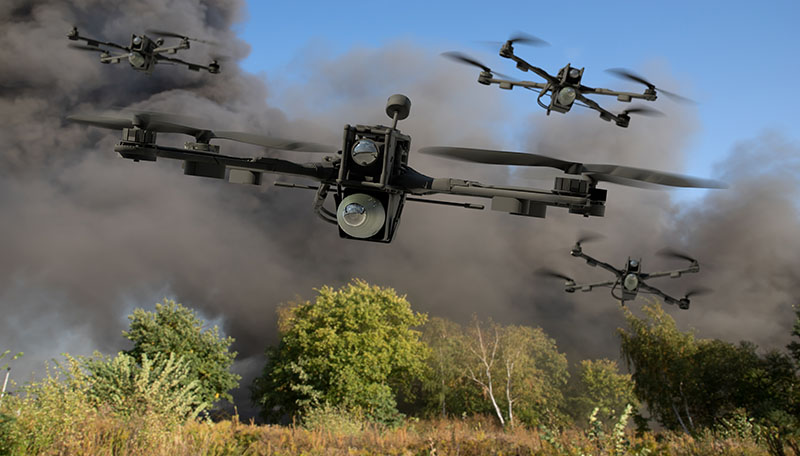Market Connector: Drone Swarm Technology

One of the most promising military innovations of late has been the development of swarm drones.
Swarm drones are small, relatively inexpensive drones that operate in unison like a swarm of bees to accomplish a goal. Like a bee swarm, a drone swarm coordinates with one another to navigate, fly in formation, make decisions, and achieve common goals while adapting to changes in real time. These drone swarms are also capable of operating autonomously through artificial intelligence technology.
While swarm drone technologies have significant potential with civilian applications in areas such as agriculture, fighting wildfires, and search and rescue, they also have demonstrated real promise with military applications. In a military theater, swarm drones can be utilized for surveillance and reconnaissance, target identification and tracking, and electronic warfare operations such as jamming and counter-jamming.
They could also be used to enforce a no-fly zone over an area, or even be armed with payloads to deliver offensive strikes. The latter use case is currently being utilized in the Russia-Ukraine war where small, nimble, hard-to-detect “kamikaze” drones costing no more than a few thousand dollars each have delivered explosive payloads to strike tanks and other hardened targets.
The technology that makes swarm drones work involves sophisticated hardware including onboard cameras, proximity sensors, and other advanced materials. Multiple firms around the world are working to develop these technologies and begin implementing swarm drones on a mass scale.
 Concept art of a drone swarm surveying an area.
Concept art of a drone swarm surveying an area.
Who: Boeing was an early investor in swarm drone technology. In 2011, the company demonstrated autonomous swarm drone reconnaissance using unmanned aerial vehicles (UAVs) that communicated via a Mobile Ad Hoc Network. The swarm successfully worked in unison to search the area by self-generating waypoints and mapping terrain, all while simultaneously sending information to ground teams. Today, the company is one of the biggest contributors toward drone swarm research and development.
Other major firms involved in drone swarm development include Northrup Grumman, Israel Aerospace Industries, and Thales.
What: For swarm drones to operate in unison, advanced materials and hardware systems are required.
Sophisticated onboard cameras on each drone in the swarm are used to capture visual data for navigation and target identification, while advanced proximity sensors prevent mid-flight collisions. Processing power and algorithms are essential to enable decentralized decision-making that allows individual drones to adapt based on real-time data. Communication systems enable real-time data exchange among swarm members. Energy-efficient components, including lightweight materials and efficient motors, allow extended flight times. Advanced sensing technologies like LiDAR and radar help drones map their environment and avoid obstacles, while redundancy systems ensure mission continuity even if a drone malfunctions.
Where: Drone swarms have use cases throughout civilian and military industries and have already proven their capabilities in some of these areas.
 Concept art of a drone swarm during military exercises.
Concept art of a drone swarm during military exercises.
In a military setting, swarm drones are effective at carrying out a variety of tasks including intelligence, surveillance, reconnaissance, and targeted strike capabilities. But they also show promise throughout many civilian roles too.
In urban settings, swarm drones could assist with traffic monitoring, disaster response, and law enforcement. In a natural disaster, these packs of drones could aid in search and rescue and surveying large areas quickly to assess damages and hazards that could threaten first responders.
Drone swarms could also help farmers monitor crops and soil health, assist civil and utility engineers with the inspection of industrial sites, infrastructure, and power lines, and even assist with scientific research in the form of wildlife tracking, data collection in remote locations, and more.
When: Swarm drones have already demonstrated their capabilities in multiple fields across civilian and military industries, and their use and capabilities are only expected to grow in the coming years.
From a military standpoint, swarm drone technology is expected to proliferate across the globe in the short term. At least eleven countries have committed to developing swarm drone programs, and more are likely to follow.
Why: From a military perspective, drone swarms are fast, efficient, smart, allow humans to remain out of harm’s way, and, when deployed with ordinance and used in a strike capacity, are lethal.
Drone swarms are an effective and relatively cost-effective way to strike enemy targets without jeopardizing the lives of soldiers. They can also carry out other military duties very efficiently due to their speed, advanced instruments, and low profile, including surveillance and reconnaissance, jamming radar or communications equipment, or practically any mission they can be adapted for.
They’re also hard to defend against. While a combatant could take down an individual drone with relative ease if it were spotted, it’s much more difficult to defend against a swarm of drones.
In civilian industries, drone swarms can assist with complex, sometimes dangerous tasks and make the jobs of farmers, scientists, engineers, manufacturers, first responders and law enforcement, and many more working professionals a little easier.
Due to their small size, swarm drones require advanced power distribution systems and fast delivery of large amounts of signal throughout their subsystems. Amphenol Aerospace offers a variety of rugged miniaturized power and signal interconnect systems that are ideal for this hardware.
About Us
Amphenol Aerospace is an industry-leading designer and manufacturer of interconnect products for the military and aerospace markets.
Search for parts through our Technology guide, or visit our Product Configurator to get 3D models of the exact configuration that you are looking for.